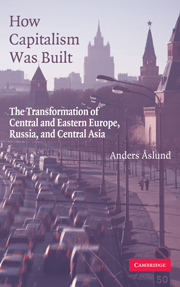Book contents
- Frontmatter
- Contents
- List of Tables and Figures
- List of Abbreviations
- Acknowledgments
- Introduction: A World Transformed
- 1 Communism and Its Demise
- 2 Shock Therapy versus Gradualism
- 3 Output: Slump and Recovery
- 4 Liberalization: The Creation of a Market Economy
- 5 From Hyperinflation to Financial Stability
- 6 Privatization: The Establishment of Private Property Rights
- 7 An Inefficient Social System
- 8 Democracy versus Authoritarianism
- 9 From Crime toward Law
- 10 The Role of Oligarchs
- 11 The Impact of the Outside World
- Conclusions: A World Transformed
- Bibliography
- Index
8 - Democracy versus Authoritarianism
Published online by Cambridge University Press: 05 September 2012
- Frontmatter
- Contents
- List of Tables and Figures
- List of Abbreviations
- Acknowledgments
- Introduction: A World Transformed
- 1 Communism and Its Demise
- 2 Shock Therapy versus Gradualism
- 3 Output: Slump and Recovery
- 4 Liberalization: The Creation of a Market Economy
- 5 From Hyperinflation to Financial Stability
- 6 Privatization: The Establishment of Private Property Rights
- 7 An Inefficient Social System
- 8 Democracy versus Authoritarianism
- 9 From Crime toward Law
- 10 The Role of Oligarchs
- 11 The Impact of the Outside World
- Conclusions: A World Transformed
- Bibliography
- Index
Summary
An important reason for the breakdown of the communist dictatorship was a split in the old elite, the Nomenklatura. Liberals in the old establishment thought they would be better off economically and also freer under a more liberal regime. Many “members of the old elite were now discovering that they could maintain their privileged positions in society even without the ideology … the party was no longer a monolith. And once it ceased to be a monolith, it was no longer viable” (Dobbs 1997, pp. 373–4). The party reformers were opposed by dogmatic hardliners who wanted to maintain the old order, and the escalating struggle between these two factions made it possible for outside reformers, often true democrats, to start playing a political role (McFaul 2001).
When communist power collapsed, the political situation changed in a revolutionary fashion. Usually, two dominant political forces emerged. One was a broad popular movement embracing democracy and freedom, and its opponent was the reformist part of the old elite; the hardliners simply disappeared. The dilemma for the rising democrats was whether to opt for a full defeat of the old system or for a compromise with its more progressive members, with whom they had cooperated until the end of communism. The new political leaders made different choices depending on preconditions, popular opinion, and their own preferences. All Central European countries started off with roundtable negotiations, whereas the abortive hard-line 1991 coup in Moscow forced abrupt transitions on all the Soviet republics.
- Type
- Chapter
- Information
- How Capitalism Was BuiltThe Transformation of Central and Eastern Europe, Russia, and Central Asia, pp. 206 - 240Publisher: Cambridge University PressPrint publication year: 2007



